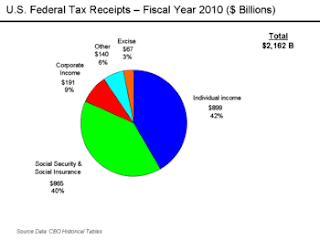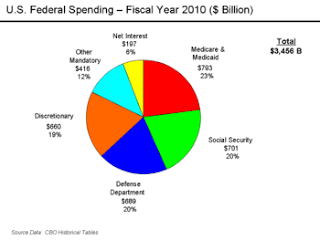There are only two ways to reduce the US government budget deficit: increase revenues or decrease expenses. Most congressional republicans are posturing that the only acceptable approach is to reduce spending. Democrats have a knee-jerk reaction against cutting spending and therefore favor increased taxes—preferably on the “rich.”
Components of US Government Revenue and Expenses
The following charts on 2010 US Federal Revenue and Expenses were taken from a Wikipedia article:
Individual income taxes are the largest component of federal revenues, followed closely behind by Social Security and Medicare revenues (FICA). These two total 82%. Corporate income tax is another 9%, leaving only 9% for excise taxes, estate taxes, user fees, etc.
It’s useful to remember that FICA taxes are split between employer and employee (with self-employed filling both roles.) Consequently, individual income and FICA taxes account for roughly 62% of revenue; corporate income and FICA account for 29%.
Our income taxes are graduated (also called progressive), which means those with higher incomes (technically higher adjusted gross incomes – “AGI”) pay a higher percentage of their income in taxes. To illustrate, in 2008, the 10% of taxpayers with the highest AGI had 46% of the income and paid 70% of the income tax. The top 1% had about 20% of the total AGI and paid about 38% of total income taxes.
FICA taxes are flat taxes (also called regressive). The portion allocated to Social Security (as opposed to Medicare) and paid by both employees and employers is 6.2% of earnings capped currently at $106,800. The portion allocated to Medicare is 1.45% of all earnings, again paid by both employees and employers.
Consequently, those in the bottom 90% of AGI paid something close to 7.65% of wages in FICA taxes. (The data is hard to extract exactly since AGI includes income other than wages and is also adjusted for deductible expenses. It may be closer to the bottom 80-85% who pay the total 7.65%, but that’s close enough for our general discussion.) Those in the top 10% on average paid something less than 4% and the top 1% paid something around 2%.
Corporate income taxes are also graduated.
What is clear from this quick analysis of revenue is that if part of the solution to addressing the annual deficit is through increased taxes, increases in personal income taxes or FICA taxes must be addressed.
Of course the current Republican stance is that we must solve the deficit through spending cuts alone, so let’s turn to expenses. Here is a chart showing where the money went:
Social Security, Medicare and Medicaid account for 43% of expenditures. Defense is about 20%. Other “mandatory” spending is 12% and so-called discretionary spending accounts for 19%. Interest expense on the accumulated debt currently runs 6%.
Unless we choose to default on our debt (something only the most radical Tea Party proponents think is a reasonable approach) we are stuck with the interest expense, and those costs will only increase each year until we balance the budget. Interest expense will only decrease if we run a budget surplus. Furthermore, interest rates are currently very, very low. If interest rates were at the same level as they were in the late 1970s and early 1980s, our interest expense would be significantly greater. (At one point 3-month treasuries were paying over 12% interest; currently they are paying 0.06%.)
In short, almost regardless of what steps we take to address the budget deficit, net interest expense will likely increase.
Many Democrats appear unwilling to change either Social Security or Medicare and even Paul Ryan's proposals defer any changes for a decade. Taxes generated for these two benefits generated about $965 billion in revenue. Payments (including Medicaid, so it isn’t quite a fair comparison) totaled $1.494 trillion. The difference is $529 billion.
We cannot address the budget deficit without addressing this significant and growing imbalance.
However, given our total deficit is $1.294 trillion, snapping our fingers and “solving” this $529 billion deficit, still leaves us with a $765 billion gap. Eliminate all $660 billion of discretionary spending and we still have $105 billion of deficit.
Defense spending is a sacred cow for many Republicans and a live wire for many Democrats, who fear any vote to decrease defense spending will brand them as “weak on national security.” The United States accounts for about 40% of worldwide arms procurement. Our GDP represents only 23% of the world’s total GDP.
We spend a greater portion of our resources on defense than average. In fact, most of the countries spending a greater percentage of their GDP on “defense” than the US are totalitarian regimes, many of whom get aid from us for their purchases. Great Britain spends 40% less of its GDP than we do; other European allies spend even less.
Reduced defense spending would require the military to innovate and prioritize. If we were to (say) match Great Britain and lop off 40% of our defense spending, we save $267 billion a year – a little over 20% of the current annual deficit.
As you have probably suspected, I favor an approach that addresses both increased revenues and decreased expenditures. In my next post I’ll discuss some approaches we should consider.
~ Jim


I AGREE WITH YOUR ANALYSIS BUT WOULD LIKE TO ADD THE TAX AVOIDANCE OF CORPORATIONS USING THE "DOULE IRISH" AND "DUTCH SANDWICH" TO AVOID PAYING TAXES SHOULD BE STOPPED. LAST 3 YEARS OF BUSH COMPARED TO 1ST 3 YEARS OBAMA RESULTED IN $170 BILLION REDUCTION TO REVENUE.THIS IS ABOUT 20% OF DEFICIT. THERE ARE GOING TO HAVE TO BE REDUCTIONS IN SOCIAL PROGRAMS BUT GROVER NORQUIST AND RYAN/ROMNEY ARE PUSHING REVENUE NUETRAL TAX CHANGES. YOU CANNOT BALANCE THE BUDGET WITHOUT CORPORATIONS PAYING THEIR SHARE.
ReplyDelete